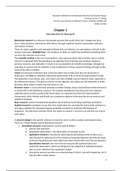Research Methods for the Behavioral Sciences by Charles Stangor
Summary of the 5th edition
For the course Research Methods: Theory and Ethics (PSBA2-08)
Femke van Rijn
Chapter 1
Introduction to Research
Behavioral research is to discover how people perceive the world, think, feel, change over time,
learn, make decisions, and interact with others, through empirical research (systematic collection
and analysis of data).
There are many cognitive and motivational biases that can influence our perceptions and lead to the
wrong conclusions. Hindsight bias = the tendency to think we could have predicted something when
we learn the outcome of an event.
The scientific method is the set of assumptions, rules and procedures that scientists use to conduct
research. It demands that the procedures are objective (free from bias and emotion), based on
previous research, and replicable. It results in an accumulation of scientific knowledge, through the
reporting of research and the addition to and modification of these reported findings through further
research by other scientists.
Values are personal statements that cannot be either true or false (and thus not be proven or
disproven), and facts are objective statements determined to be accurate through empirical study.
The distinction is not always clear, since there are often multiple ways to interpret data, especially in
the behavioral sciences. The goal of science is to be objective, but values are still important to make
decisions about what to study, how and whom to use.
Research report = a document that presents scientific findings using a standardized written format (it
is mostly APA in the behavioral sciences). The sections Introduction and Discussion are relatively
subjective (they involve questions like which topics are important and how the data should be
interpreted), while Method and Results are completely objective (they describe the procedures and
statistical analyses).
Basic research answers fundamental questions about behavior (providing underlying principles).
Applied research investigates issues that have implications for everyday life and provide solutions to
everyday problems (for example program evaluation research to study the effectiveness of
programs). The distinction between these two types of research is not clear-cut and they can inform
each other.
A research design is the specific method a researcher uses to collect, analyze and interpret data.
There are 3 basic designs used in behavioral research.
1. Descriptive research (assessing the current state of affairs)
a. Surveys and interviews
b. Naturalistic observation = the observation of everyday events
c. Qualitative research is focused on observing and describing events as they occur,
with the goal of capturing all of the richness of everyday behavior and with the hope
of discovering phenomena that might have been missed with more formal measures.
Quantitative research uses more formal measures like questionnaires and
systematic observation, which are designed to be subjected to statistical analyses
and are more objective than qualitative studies.
d. Descriptive research provides an understanding of what is currently happening, but it
only provides a static picture.
1





